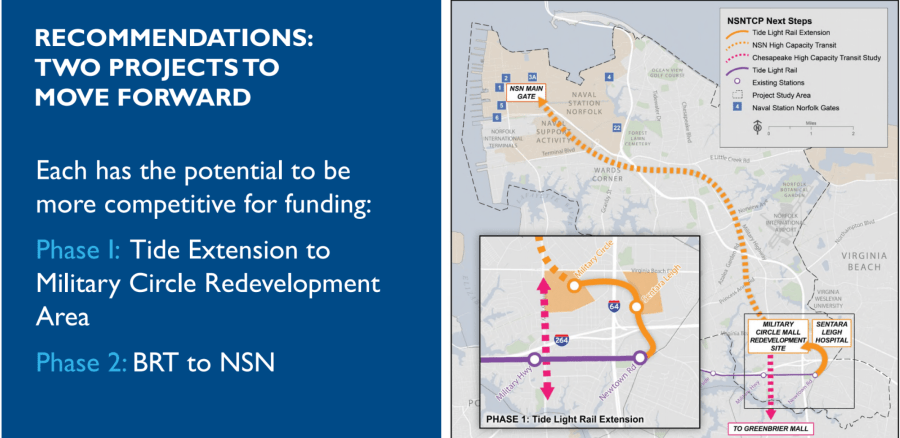NORFOLK, Va. (WAVY) — After several years of study, Hampton Roads Transit believes the best way to connect Norfolk’s largest employer and its existing light rail system, is with a slight expansion and a new to the region concept called bus rapid transit.
The recommendation on the two-phase plan, which would ultimately connect Naval Station Norfolk to Miltary Circle and possibly Chesapeake’s Greenbrier area via a rapid transit system, was presented to Norfolk City Council Friday during their retreat.
Planners with HRT said not only would it reconnect communities, but it could likely reduce road traffic in some of the region’s busier locations.
The existing 7.3-mile long light rail system currently runs from the Eastern Virginia Medical Center complex to Newtown Road at the Norfolk-Virginia Beach border.
Long mocked as the “the light rail to nowhere,” phase 1 of the recommended plan calls for expanding The Tide — Norfolk’s light rail system — two miles to Sentara Leigh Hospital and Military Circle.
Ray Amoruso, HRT’s chief planning and development officer, told City Council that this would give the light rail more of a solid anchor.
“Those who live east of [Interstate] 64. There is no walkability to the military highway redevelopment area. Light rail provides that correction,” Amoruso said.
However, in trying to extend the line further to Naval Station Norfolk, where an estimated 60,000 to 70,000 people travel every day, a multi-year study found running tracks there wouldn’t be worth the $1 billion price tag.

So, Amoruso said they are looking at establishing bus rapid transit, not unlike Richmond’s Pulse system.
Riders would still board a bus, but they would board at station platforms similar to light rail and travel in their own dedicated lanes.
Phase II of HRT’s recommendation is to establish bus rapid transit from Naval Station Norfolk to Summit Pointe, the new mixed-use development where Dollar Tree is headquartered in Chesapeake.
“We are going to be soliciting requests for proposals this spring to conduct a study to look at what makes the most sense from Summit Point in Greenbrier,” Amoruso said. “Do we run it up Greenbrier Parkway? Do we run it up Battlefield Boulevard? How do we get to the Military Highway?”
He said where both the light rail and bus rapid transit meet — at Military Circle — is key.
In the spring, Norfolk City Council could pick its preferred developer to transform the area from a decaying regional shopping mall to a planned community with a 15,000 seat arena.
“What a beautiful thing it would be to connect all of that with modern mass transit,” Amoruso said.
However, construction would be at least eight years away. Amoruso said very preliminary estimates for the project total $300 million. But he said the federal government could likely pick up 51% of the cost.
What he said would need to happen this year, is a vote of support from City Council in order to apply for state Smart Scale funding.
The whole system could be operational by 2033.
























